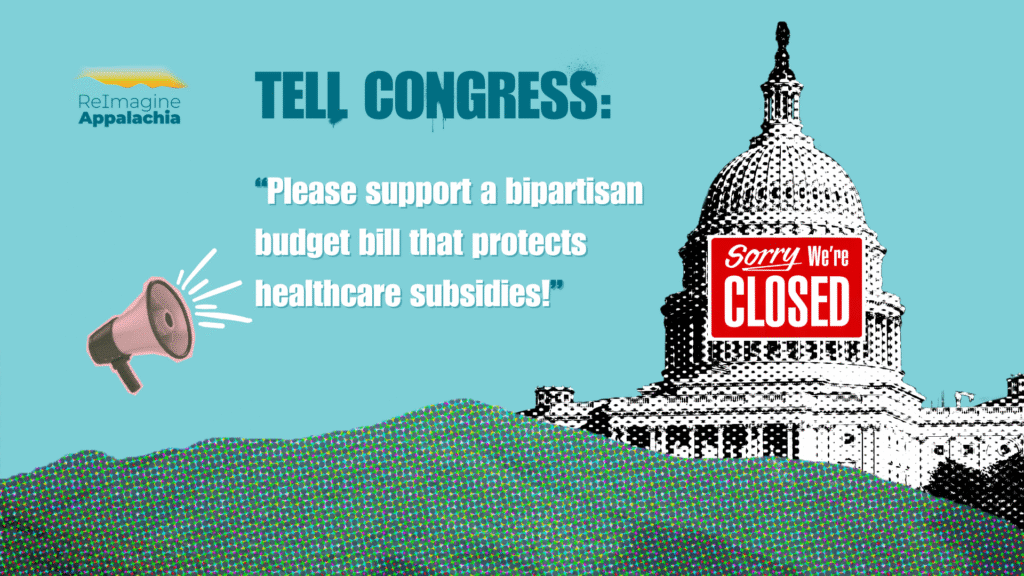
October 17, 2025
Since the shutdown began on October 1, an estimated 4,000+ workers have been fired, 10 failed attempts to pass a spending bill have been made, and there is no immediate end in sight.
Since early October, we’ve been sharing updates about the shutdown, as well as some of the information we’ve gathered from our partners about how it is impacting the region. As we move into yet another week of shutdown, here’s another update.
Take Action Here!
If you want to reach out to your members of Congress about this, we have created an easy tool for you here.
SNAP is expected to lack sufficient funds by November
Ronald Ward, the acting head of the Supplemental Nutrition Assistance Program (SNAP), has said that the program only has enough funding to continue running through the month of October. Appalachia is home to 3.4 million food-insecure households, according to the 2020 Census. SNAP distributes electronic benefits that people can use to purchase food and provides assistance to 42 million Americans. The Women, Infants, and Children (WIC) program and school lunch reimbursements are also at risk of funding gaps if action isn’t taken.
Affordable Care Act (Obamacare) COVID-era subsidies at risk
Ronald Ward, the acting head of the Supplemental Nutrition Assistance Program (SNAP), has said that the program only has enough funding to continue running through the month of October. Appalachia is home to 3.4 million food-insecure households, according to the 2020 Census. SNAP distributes electronic benefits that people can use to purchase food and provides assistance to 42 million Americans. The Women, Infants, and Children (WIC) program and school lunch reimbursements are also at risk of funding gaps if action isn’t taken.
ReImagine’s Programs Director, Dana Kuhnline, speaks with Joe Kennedy, Founder at Groundwork Project, about how the 2025 shutdown is likely to impact Appalachian communities. Watch the full interview here.
Mass firings have begun – and been paused
President Trump had threatened to begin permanent firings of federal employees during the shutdown, and this week moved to fire 4,000 workers across eight federal agencies. On Wednesday, Oct 15th a federal judge temporarily blocked the Trump administration from conducting mass federal layoffs during the government shutdown, siding with unions that have argued that the firings were illegal. As this plays out, it’s important to note that firings do nothing to resolve the larger budget issues at play in the shutdown negotiations. Any firings that occur will simply be because the administration wanted to fire federal workers, and, as Russell Vought, Director of the Office of Management and Budget (OMB) has said, traumatize federal workers. Vought has shared plans to fire up to 10,000 federal workers, with the stated purpose for these cuts being, in part, to “punish Democrats.”
Which federal workers have missed a paycheck?
Because federal pay periods vary, this is the first week that many federal workers have faced a reduced or missing paycheck. If the shutdown continues into a second pay period, lost wages will become more severe in coming weeks. Members of the military were due to miss their first paycheck on October 15th; a last-minute order reallocated funds to prevent that. While some departments can reallocate funds, air traffic controllers are one example of a federal position without a mechanism to receive pay during the shutdown.
The White House has hinted that it’s considering withholding backpay for federal employees. It’s worth noting that this would be a violation of the Government Employee Fair Treatment Act, a law passed by Congress in 2019 following the 35-day shutdown under Trump’s first term. This article has more information on which civilian and military workers have been pay, with some state-by-state analysis.
Can we still visit our national parks?
Appalachia’s national parks are some of the crown jewels of our region, and the Autumn glory of changing leaves is a time for peak tourism funds for local economies. Local governments and non-profits have stepped up to keep Great Smoky National Park open, but those funds are uncertain after October 19th. The state of West Virginia stepped up to keep New River Gorge and Harper’s Ferry National parks open till October 31st, but that deadline is swiftly coming as well. State funding will allow Bridge Day; West Virginia’s largest single-day event which brings tens of thousands of people to the New River Gorge, to take place tomorrow, on Saturday, October 18th.
Unpacking the shutdown’s impacts on the region:
ReImagine’s Programs Director, Dana Kuhnline, speaks with Joe Kennedy, Founder at Groundwork Project, about how the 2025 shutdown is likely to impact Appalachian communities. Watch the full interview here.
Ongoing impacts we shared last week:
Appalachian Regional Commission Impacts: According to the Appalachian Regional Commission’s Shutdown Plan, they should be able to maintain capacity for twelve weeks. This NACO resource on the shutdown covers the status of many federal agencies.
Federal grant management: Because grants officers and other staff are often furloughed, there can be delays in payments, technical support, etc. Take care to document all of your outreach attempts for compliance and meet deadlines even if the officers are furloughed.
Upcoming grants and new awards: Proceed as if deadlines are not changing, but be aware that they can change. If you have submitted an application or plan to submit one, expect a delay in notification. Save a dated copy of your full application with confirmation of submission.
Cancelled Department of Energy Programs: One of the things we’ve heard from the Trump administration is that they will be taking actions in retaliation against programs as part of their shutdown strategy. One of the actions we’ve seen has included two rounds of rumored cancellations of DOE grants last week and this week, the most recent list included several dozen programs in Appalachia. The Department of Energy has refused to confirm if these programs are truly cancelled, but many of the programs have seen a slow-walking of funding and delays that cast uncertainty on the important work of these projects. These rumored lists of cuts are another layer of chaos that leaders in our region have to navigate.
The Department of Energy has told employees to avoid using certain words, including “climate change,” “green” and “sustainable”.
Workplace Safety: Another piece to look out for is worker safety and compensation. For example, the Wage and Hour Division has paused more regulatory and enforcement activities; only 10 out of a pre-shutdown total of 1,270 employees remain active.
Reduced Disaster Preparedness: With the federal agencies that help us predict storms, like NOAA and the National Weather Service, and agencies that help us recover from storms, like FEMA, already eroded, we’re more vulnerable to the impacts of natural disasters already, and reduced federal capacity during a shutdown increases risk due to both less accurate storm tracking and reduced ability to respond to emergencies.
Other Disaster Preparedness related impacts include a halt to the National Flood Insurance program. Because new policies can’t be created during the shutdown, homeowners are being forced to postpone home sales or rely on more expensive and less reliable private flood insurance.
What’s next?
A functional, fair and transparent United States government is not a partisan issue. The issues at hand- access to healthcare, consumer protections, basic infrastructure, and more – have strong support across the aisle. At a rally in Cleveland this week, Ohio AFL-CIO president Tim Burga stated, “Like many Americans, we are tired of the political games being played with the livelihoods of our federal workers.”

